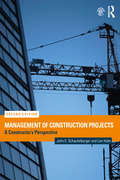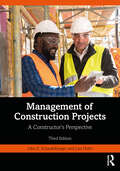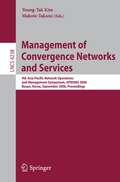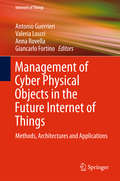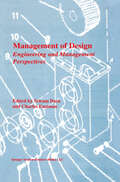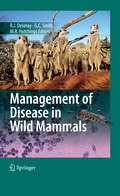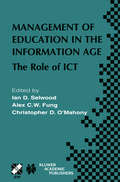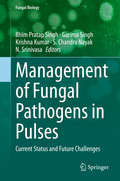- Table View
- List View
The Management of Construction: A Project Lifecycle Approach
by F. Lawrence BennettManagement of Construction introduces all aspects of management practice to students and professionals based in the construction industry. It is also important for those involved in allied fields such as design, project development, and site monitoring and inspection. The book addresses each stage of the construction project from conception to completion, giving a perspective on the whole life cycle often missing from textbooks. The author also balances engineering concerns with the human resource and personal aspects of construction management that are so important to the successful outcome of a project.
The Management of Construction: A Project Lifecycle Approach
by F. Lawrence BennettManagement of Construction introduces all aspects of management practice to students and professionals based in the construction industry. It is also important for those involved in allied fields such as design, project development, and site monitoring and inspection. The book addresses each stage of the construction project from conception to completion, giving a perspective on the whole life cycle often missing from textbooks. The author also balances engineering concerns with the human resource and personal aspects of construction management that are so important to the successful outcome of a project.
Management of Construction Projects
by Brian CookeConstruction Management is a wide ranging discipline, but ultimately it is a demanding, hands-on discipline concerned with the management of people, plant and materials, all mobilised to complete a building project safely, on time, on budget and to the client’s satisfaction. Management of Construction Projects is a highly illustrated series of case studies based on seven live construction management projects, demonstrating the very practical nature of managing projects. The detailed case studies cover a variety of construction projects, varying in value from £1million to £117 million, including a major inner city office block, a portal framed factory unit, a university refurbishment project, a superstore & car park and a new school building. The case studies emphasise detailed on site management procedures and identify a predominantly functional approach to managing projects. A number of related chapters covering practical and theoretical aspects of construction management support and illustrate the individual case studies. With a strong emphasis on the practical nature of the subject, Management of Construction Projects is an ideal introduction to the subject for all students on construction and related degree and diploma programmes. It will be of particular interest to students preparing for the CIOB EPA programme and the new NVQ courses at level 4 and 5 in construction management.
Management of Construction Projects
by Brian CookeConstruction Management is a wide ranging discipline, but ultimately it is a demanding, hands-on discipline concerned with the management of people, plant and materials, all mobilised to complete a building project safely, on time, on budget and to the client’s satisfaction. Management of Construction Projects is a highly illustrated series of case studies based on seven live construction management projects, demonstrating the very practical nature of managing projects. The detailed case studies cover a variety of construction projects, varying in value from £1million to £117 million, including a major inner city office block, a portal framed factory unit, a university refurbishment project, a superstore & car park and a new school building. The case studies emphasise detailed on site management procedures and identify a predominantly functional approach to managing projects. A number of related chapters covering practical and theoretical aspects of construction management support and illustrate the individual case studies. With a strong emphasis on the practical nature of the subject, Management of Construction Projects is an ideal introduction to the subject for all students on construction and related degree and diploma programmes. It will be of particular interest to students preparing for the CIOB EPA programme and the new NVQ courses at level 4 and 5 in construction management.
Management of Construction Projects: A Constructor's Perspective
by John E. Schaufelberger Len HolmUnlike the majority of construction project management textbooks out there, Management of Construction Projects takes a distinctive approach by setting itself in the context of a single and real-world construction project throughout and also by looking at construction project management from the constructor’s perspective. This project-based learning approach emphasizes the skills, knowledge, and techniques students require to become successful project managers. This second edition uses a brand new, larger, and more challenging case study to take students through key stages of the process, including: contracts and subcontracting; estimating, scheduling, and planning; supply chain and materials management; cost control, quality, and safety; project leadership and ethics; and claims, disputes, and project close-outs. Also new to this edition is coverage of emergent industry trends such as LEAN, LEED, and BIM. The book contains essential features such as review questions, exercises, and chapter summaries, while example plans, schedules, contracts, and other documents are stored on a companion website. Written in straightforward language from a constructor’s perspective, this textbook gives a realistic overview and review of the roles of project managers and everything they need to know in order to see a successful project through from start to finish.
Management of Construction Projects: A Constructor's Perspective
by John E. Schaufelberger Len HolmUnlike the majority of construction project management textbooks out there, Management of Construction Projects takes a distinctive approach by setting itself in the context of a single and real-world construction project throughout and also by looking at construction project management from the constructor’s perspective. This project-based learning approach emphasizes the skills, knowledge, and techniques students require to become successful project managers. This second edition uses a brand new, larger, and more challenging case study to take students through key stages of the process, including: contracts and subcontracting; estimating, scheduling, and planning; supply chain and materials management; cost control, quality, and safety; project leadership and ethics; and claims, disputes, and project close-outs. Also new to this edition is coverage of emergent industry trends such as LEAN, LEED, and BIM. The book contains essential features such as review questions, exercises, and chapter summaries, while example plans, schedules, contracts, and other documents are stored on a companion website. Written in straightforward language from a constructor’s perspective, this textbook gives a realistic overview and review of the roles of project managers and everything they need to know in order to see a successful project through from start to finish.
Management of Construction Projects: A Constructor's Perspective
by John Schaufelberger Len HolmUnique among construction project management textbooks, Management of Construction Projects, third edition, takes the constructor’s perspective, carefully analyzing a complex, real-world construction case study from multiple angles to demonstrate the skills, knowledge, and techniques students require to become successful project managers. Popular as an undergraduate text and as a contractor resource, the book identifies key stages of the project-management process, such as delivery methods and contracts; estimating, planning, and scheduling; preconstruction services; subcontracting and material management; documentation, communications, and payment; controls, quality, and safety; leadership and ethics; and claims, disputes, and close-out.This third edition includes a novel case study, a new chapter on preconstruction services, updated contract forms and figures, and additional student exercises, and integrates use of project management technology. Topics include building information models, sustainable construction, environmental compliance, lean construction, and off-site construction. Boxed examples, or short case studies, have been included with each chapter. These examples correspond directly to the chapters in which they are included and give the reader an applied approach to learning the concepts presented.While primarily focused on the management of commercial projects, the principles and techniques in Management of Construction Projects also apply to residential, industrial, and heavy construction. Written in straightforward language from a constructor’s perspective, this textbook prepares upcoming construction project managers with everything they need to see a successful project through from start to finish.
Management of Construction Projects: A Constructor's Perspective
by John Schaufelberger Len HolmUnique among construction project management textbooks, Management of Construction Projects, third edition, takes the constructor’s perspective, carefully analyzing a complex, real-world construction case study from multiple angles to demonstrate the skills, knowledge, and techniques students require to become successful project managers. Popular as an undergraduate text and as a contractor resource, the book identifies key stages of the project-management process, such as delivery methods and contracts; estimating, planning, and scheduling; preconstruction services; subcontracting and material management; documentation, communications, and payment; controls, quality, and safety; leadership and ethics; and claims, disputes, and close-out.This third edition includes a novel case study, a new chapter on preconstruction services, updated contract forms and figures, and additional student exercises, and integrates use of project management technology. Topics include building information models, sustainable construction, environmental compliance, lean construction, and off-site construction. Boxed examples, or short case studies, have been included with each chapter. These examples correspond directly to the chapters in which they are included and give the reader an applied approach to learning the concepts presented.While primarily focused on the management of commercial projects, the principles and techniques in Management of Construction Projects also apply to residential, industrial, and heavy construction. Written in straightforward language from a constructor’s perspective, this textbook prepares upcoming construction project managers with everything they need to see a successful project through from start to finish.
Management of Contaminated Site Problems, Second Edition
by Kofi Asante-DuahThis book will outline the strategies used in the investigation, characterization, management, and restoration and remediation for various contaminated sites. It will draw on real-world examples from across the globe to illustrate remediation techniques and discuss their applicability. It will provide guidance for the successful corrective action assessment and response programs for any type of contaminated land problem, and at any location. The systematic protocols presented will aid environmental professionals in managing contaminated land and associated problems more efficiently. This new edition will add twelve new chapters, and be fully updated and expanded throughout.
Management of Contaminated Site Problems, Second Edition
by Kofi Asante-DuahThis book will outline the strategies used in the investigation, characterization, management, and restoration and remediation for various contaminated sites. It will draw on real-world examples from across the globe to illustrate remediation techniques and discuss their applicability. It will provide guidance for the successful corrective action assessment and response programs for any type of contaminated land problem, and at any location. The systematic protocols presented will aid environmental professionals in managing contaminated land and associated problems more efficiently. This new edition will add twelve new chapters, and be fully updated and expanded throughout.
Management of Convergence Networks and Services: 9th Asia-Pacific Network Operations and Management Symposium, APNOMS 2006, Busan, Korea, September 27-29, 2006, Proceedings (Lecture Notes in Computer Science #4238)
by Young-Tak Kim Makoto TakanoThis book constitutes the refereed proceedings of the 9th Asia-Pacific Network Operations and Management Symposium, APNOMS 2006. The book presents 50 revised full papers and 25 revised short papers, organized in topical sections on management of ad hoc and sensor networks, network measurements and monitoring, mobility management, QoS management, management architectures and models, security management, E2E QoS and application management, management experience, NGN management, and IP-based network management.
Management of Cyber Physical Objects in the Future Internet of Things: Methods, Architectures and Applications (Internet of Things)
by Antonio Guerrieri Valeria Loscri Anna Rovella Giancarlo FortinoThis book focuses on new methods, architectures, and applications for the management of Cyber Physical Objects (CPOs) in the context of the Internet of Things (IoT). It covers a wide range of topics related to CPOs, such as resource management, hardware platforms, communication and control, and control and estimation over networks. It also discusses decentralized, distributed, and cooperative optimization as well as effective discovery, management, and querying of CPOs. Other chapters outline the applications of control, real-time aspects, and software for CPOs and introduce readers to agent-oriented CPOs, communication support for CPOs, real-world deployment of CPOs, and CPOs in Complex Systems. There is a focus on the importance of application of IoT technologies for Smart Cities.
Management of Data Center Networks (IEEE Press Series on Networks and Service Management)
by Nadjib AitsaadiThis book examines different aspects of Data Center Networks (DCNs) and describes the special techniques in managing this kind of network. DCN becomes increasingly popular with the advent of cloud computing and multimedia social networks employing new transmission technologies such as 5G wireless and wireless fiber. The book begins with the lead editor setting the stage in the introduction and first chapter, followed by chapters written by other experts covering the various aspects of DCN. These topics include routing and reliability of inter-data center networks, energy management, security, and more.
Management of Data Center Networks (IEEE Press Series on Networks and Service Management)
by Nadjib AitsaadiThis book examines different aspects of Data Center Networks (DCNs) and describes the special techniques in managing this kind of network. DCN becomes increasingly popular with the advent of cloud computing and multimedia social networks employing new transmission technologies such as 5G wireless and wireless fiber. The book begins with the lead editor setting the stage in the introduction and first chapter, followed by chapters written by other experts covering the various aspects of DCN. These topics include routing and reliability of inter-data center networks, energy management, security, and more.
Management of Design: Engineering and Management Perspectives
by Sriram Dasu Charles EastmanProduct design significantly influences product cost and quality, as well as market share and profitability of a firm. Design projects often involve many people belonging to different functional areas and in many organizations several design projects may be under way at the same time. Due to this complexity, management of design has given rise to a rich set of research problems in management and engineering. In this volume, design is considered as the planning and specification activity prior to fabrication. Design determines what products will be produced, how they will be produced, and when they will be introduced into the market. The quality of the products and the speed with which they are developed are significantly affected by the design process. The design process by which a product is developed is determined by the managerial and engineering practices, tools and techniques. This book presents engineering and management perspectives on design. Topics covered include: Decomposition of product development projects; Tools and techniques for preliminary evaluation of designs; Interface between design and manufacturing, assembly and distribution; Design information flows, and Determination of the scope, timing and duration of projects, and the allocation of resources.
Management of Disease in Wild Mammals
by Richard Delahay Graham C. Smith Michael R. HutchingsIn recent years nobody could have failed to notice the frequent and often sensati- alist media headlines warning of the latest global disease threat to humankind. But behind all the hyperbole lie real challenges related to dealing with the increasing incidence of emerging zoonotic disease events, the majority of which are thought to originate in wildlife (Jones et al. 2008). There are also many important diseases of domestic livestock which also occur in wildlife (e. g. foot and mouth disease and classical swine fever in wild boar, bovine tuberculosis in deer, badgers or possums), some of which can have a devastating impact on the farming industry, the wider rural economy and ultimately the public purse. But we should also not forget that wildlife diseases may have serious implications for the conservation of biodiversity. For some of the rarest, most endangered species (such as the Ethiopian wolf) d- ease may pose the greatest threat to their survival. If we are to avoid or reduce these impacts then we must improve our ability to detect and manage the risks associated with disease in wildlife populations. This is a challenge that will require expertise from many different disciplines: veterinary, ecological, medical, economic, poli- cal and zoological. In such an interdisciplinary field it is difficult to stay up to date with contemporary ideas and with techniques that may be rapidly evolving.
Management of Education in the Information Age: The Role of ICT (IFIP Advances in Information and Communication Technology #120)
by Christopher D. O’Mahony Alex C. W.Fung Ian D. SelwoodThis volume presents findings and insights from contemporary thinking and research on the application of Information Technology in Educational Management. It analyzes the ways in which ICT has been used, across a range of educational institutions, to support various aspects of educational management. It is the latest in a series of books produced by IFIP Working Group 3.7.
Management of Electronic Waste: Resource Recovery, Technology and Regulation
by Anshu PriyaMANAGEMENT OF ELECTRONIC WASTE Holistic view of the current and future trends in electronic waste management, focusing on recycling, technologies, and regulations Management of Electronic Waste delivers a complete overview of all aspects related to the toxicity characterization of electronic wastes, along with other important topics including resource recovery, recycling strategies, biotechnological advancements, and current perspectives on waste generation and management. The book presents hazards associated with conventional recycling methods and highlights environmentally compatible economic approaches for resource recovery, along with eco-friendly strategies for management of electronic wastes. The high metallic content, heterogeneous and composite nature of e-wastes make them a rich secondary reservoir of metals. The book explores the valuable potential of e-waste and highlights the eco-friendly, sustainable technologies and recycling strategies for the profitable and effective conversion of waste to wealth. Written by a highly qualified and internationally renowned author, Management of Electronic Waste covers sample topics such as: Rise of e-waste generation paired with rising economies and mounting demand for electrical and electronic devices, with a country-by-country breakdown Status of e-waste management and recycling efforts around the world, along with key processes that drive e-waste recycling Macroeconomic trends between global demand and supply for metal resources and the transition of linear to circular economy Bioleaching, an economic and green approach for recovery of metals, from e-waste and other low grade metal repositories Different metallurgical approaches for extraction and recovery of resources from e-waste and their pros and cons Filling a gap on the understudied biotechnological recycling techniques and methods for mitigating environmental pollution caused by electronic waste, Management of Electronic Waste serves as an excellent guide on the subject for electronic waste producers, consumers, recycling industries, policy and law makers, academicians, and researchers.
Management of Electronic Waste: Resource Recovery, Technology and Regulation
by Anshu PriyaMANAGEMENT OF ELECTRONIC WASTE Holistic view of the current and future trends in electronic waste management, focusing on recycling, technologies, and regulations Management of Electronic Waste delivers a complete overview of all aspects related to the toxicity characterization of electronic wastes, along with other important topics including resource recovery, recycling strategies, biotechnological advancements, and current perspectives on waste generation and management. The book presents hazards associated with conventional recycling methods and highlights environmentally compatible economic approaches for resource recovery, along with eco-friendly strategies for management of electronic wastes. The high metallic content, heterogeneous and composite nature of e-wastes make them a rich secondary reservoir of metals. The book explores the valuable potential of e-waste and highlights the eco-friendly, sustainable technologies and recycling strategies for the profitable and effective conversion of waste to wealth. Written by a highly qualified and internationally renowned author, Management of Electronic Waste covers sample topics such as: Rise of e-waste generation paired with rising economies and mounting demand for electrical and electronic devices, with a country-by-country breakdown Status of e-waste management and recycling efforts around the world, along with key processes that drive e-waste recycling Macroeconomic trends between global demand and supply for metal resources and the transition of linear to circular economy Bioleaching, an economic and green approach for recovery of metals, from e-waste and other low grade metal repositories Different metallurgical approaches for extraction and recovery of resources from e-waste and their pros and cons Filling a gap on the understudied biotechnological recycling techniques and methods for mitigating environmental pollution caused by electronic waste, Management of Electronic Waste serves as an excellent guide on the subject for electronic waste producers, consumers, recycling industries, policy and law makers, academicians, and researchers.
The Management of Enclosed and Domesticated Deer: International Husbandry Systems and Diseases
by John FletcherThis is the first book devoted to international deer husbandry techniques for the growing industries of venison, velvet antler, and antler trophy production as well as long established extensive park systems for amenity. Written by world leaders in their specialised subjects, chapters shed light on widely differing management systems and the optimum design of deer farms, handling yards and fencing layouts. Moreover, readers will discover the requisites of good stockmanship and specialist veterinarians describe different diseases the deer may develop. Details on available treatments, the general biology of deer and an explanation of controversial ethics of velvet and trophy production complete this work.As deer farming has come of age this collection is timely. At fifty years the New Zealand deer industry carries one million animals with annual venison exports to America, Europe and growing antler markets in China and Korea. Chinese antler production is well-established and Asian reindeer husbandry even more ancient. In North America and Europe, deer are now being kept for antler trophies and amenity in many historic parks. This volume is a valuable resource for everyone researching deer management systems, be it practising veterinarians, deer farmers, park managers or agricultural and veterinary students.
Management of Engineering Projects
by Richard StoneA text relevant to the whole spectrum of engineering which focuses on the administrative, financial and legal aspects of project management. Topics covered include project development and evaluation, management of people, time and budgets and health and safety aspects. Case studies are included.
Management of Food Allergens
by Jacqueline Coutts Richard FielderOne of the greatest challenges facing the food industry is providing safe food to an ever-increasing number of allergic consumers through a global supply chain. Approximately 2–4% of western adults and up to 10% of children are currently thought to be sensitive to food allergens, and the issue is of major commercial significance to food manufacturers. The market for ‘free-from’ foods has grown dramatically in recent years and the demand for gluten- and dairy-free foods shows no sign of abating in the foreseeable future. This volume provides an overview of the safe management of food allergens, aiming to help all those with a vested interest in understanding how to protect consumer health through good manufacturing practice and clear labelling advice. It examines the risk management systems and practices being adopted by the food industry to tackle the growing hypersensitivity of consumers to a range of food proteins. The various aspects of the subject are addressed from a range of perspectives including that of researcher, food manufacturer, enforcement officer, clinician and consumer. There will be an emphasis on the scientific analysis of food and environmental samples and their use in verifying in-process controls and finished-product labelling claims. The book is directed at food scientists and technologists based in industry and research, quality assurance personnel, clinicians and public health officials.
Management of Fungal Pathogens in Pulses: Current Status and Future Challenges (Fungal Biology)
by Bhim Pratap Singh Garima Singh Krishna Kumar S. Chandra Nayak N. SrinivasaPulses have played a major role in human diet and are considered a rich source of proteins. But, the major constraints in achieving the yield of pulses are the occurrences of various diseases and pests. Hence, there is a need to understand major fungal pathogens and their management strategies for sustainable agriculture. The major pulse crops in India and other Asian countries are bengal gram, pigeon pea, black gram, green gram, lentil and peas, which are attacked by several pathogens that cause considerable crop damage. Bengal gram is affected mainly by wilt (Fusarium oxysporum f. sp. ciceri), blight (Mycosphaerella pinodes) and rust (Uromyces ciceris-arietini). The main diseases of pigeon pea are wilt (Fusarium oxysporum) and Phytophtora stem blight (Phytophthora drechsleri f. sp. cajani). Powdery mildew (Erysiphe polygoni) and rust (Uromyces vicia-fabae) are the most important diseases affecting the production of pea. This volume offers details like symptoms, distribution, pathogens associated, predisposing factors and epidemiology, sources of resistance and holistic management of diseases with particular reference to those of economic importance. Several minor diseases of lentil, green gram and of black gram are discussed with their detailed and updated information. This volume provides pooled information regarding the management of major fungal phytopathogens affecting pulses.
Management of Global Construction Projects
by David Moore Andrew Price Edward OchiengThe first textbook of its kind, taking a uniquely global approach to project management in construction. Using a wealth of case studies from around the world to explain theory and practice, the authors take a business-oriented, decision-making approach to project management and the challenges it faces in the modern world. The book covers topics highly relevant to the challenges and opportunities currently facing the global construction industry, including managing culturally-diverse and globally dispersed teams, international project finance and global stakeholders in projects.Management of Global Construction Projects is essential reading for both students of construction management and professionals looking to understand construction project management in a truly global context.
Management of Greywater in Developing Countries: Alternative Practices, Treatment and Potential for Reuse and Recycling (Water Science and Technology Library #87)
by Radin Maya Radin Mohamed Adel Ali Al-Gheethi Amir Hashim Mohd KassimThis book reviews the consequences of improper disposal of greywater into the environment and the most appropriate treatment technologies for developing countries, focusing on the potential to reuse greywater as a production medium for biomass and bio-products. It also describes the quantities and qualitative characteristics, as well as the common practice of discharging greywater in developing countries, and highlights the associated health risks. Further, it compares the management of greywater in developed and developing countries and explores the advantages and disadvantages of various treatment technologies, discussing the reuse of greywater for irrigation purposes in arid and sub-arid countries, especially in the Middle East. The book shows the benefits of greywater and introduces low-cost technologies based on the available local facilities can be used to discharge, reuse, and recycle it.


